A wide angle lens is the go-to choice for many landscape photographers. If you shoot with a Sony mirrorless camera that has an E mount, you have plenty of quality wide angle lenses to choose from. On this page we’ll take a look at eight of the best options. While they are ranked in order, all of them are good quality lenses and they are only mentioned here because they made the cut as one of the best.
This list includes mostly prime lenses, but there are some zoom lenses as well. Read the details of each and decide which one is the best fit for your needs.
Reviews of the Best Wide Angle Lenses for Sony E Mount
8. Rokinon 12mm f/2.0 NCS CS Lens
If you’re looking for a quality, budget-friendly wide angle lens for a Sony mirrorless camera with an APS-C sensor, this is a great option. You should also be aware that this is a manual focus lens, with no auto focus. If you are ok with manual focus, this lens will produce excellent quality images, especially considering its low price tag. The 12mm focal length has an equivalence of 18mm on a cropped sensor.
It has a maximum aperture of f/2, making it very effective in low light situations. The minimum aperture is f/22. This is a lightweight lens, at around 8.5 ounces.
- For APS-C sensors
- focal length: 12mm (18mm equivalent)
- aperture range: f/2 – f/22
- 67mm front filter diameter
- auto focus: no
- weight: 8.6 oz.
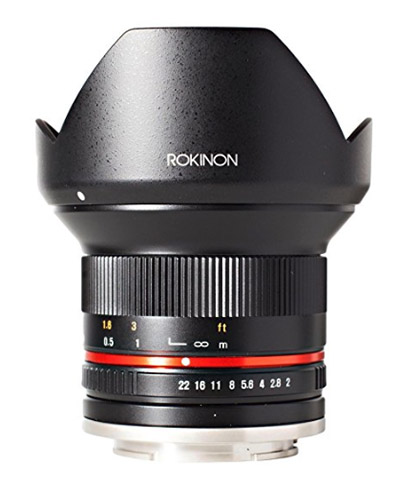
Rokinon 12mm f/2.0 NCS CS Lens
7. Sony FE 28mm f/2 Lens
This is another budget-friendly option, but this one is for full-frame cameras (although it can also be used with APS-C sensors). At 28mm it is wide, but not ultrawide. Depending on your needs it may be wide enough, or you may want to go with another option. For landscape photography there are a lot of situations where you may want something wider than 28mm.
The max aperture of f/2 is great, and the lens is capable of producing high-quality, sharp images. It is also dust and moisture resistant. While we don’t have it rated as high as some other lenses, it’s an excellent option if the 28mm meets your needs and if your budget is limited.
- For full frame or APS-C sensors
- focal length: 28mm (42mm equivalent)
- aperture range: f/2 – f/22
- 49mm front filter diameter
- auto focus: yes
- weight: 7 oz.
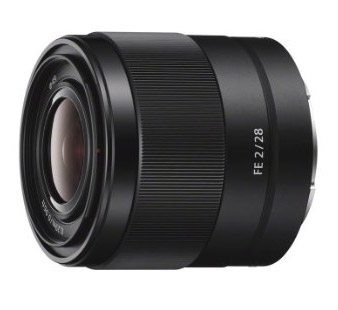
Sony FE 28mm f/2 Lens
6. Venus Optics Laowa 12mm f/2.8 Zero-D Lens
We now step up a good bit in price with this 12mm prime lens. It features a maximum aperture of f/2.8, which is more than adequate for landscape photography. This lens is made for cameras with full frame sensors, but it can also be used with APS-C sensors. The 12mm focal length on a full frame camera gives you an ultra wide angle that you will love (equivalent to 18mm for APS-C sensors).
Like the Rokinon lens mentioned earlier, this one is a manual focus lens. It’s also considerably heavier than some of the other lenses on this list, weighing about 1.3 pounds. However, it is still an excellent quality lens. It is designed to limit the distortion that can be common with ultra wide angle lenses.
- For full frame or APS-C sensors
- focal length: 12mm (18mm equivalent)
- aperture range: f/2.8 – f/22
- no front filter thread
- auto focus: no
- weight: 1.3 pounds
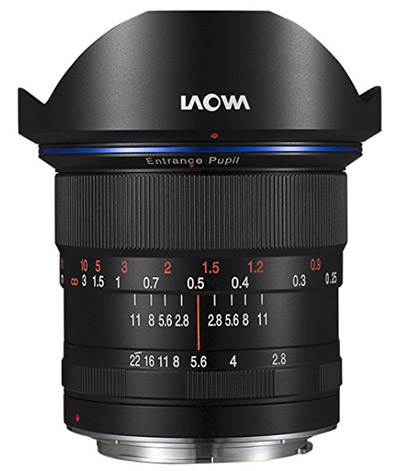
Venus Optics Laowa 12mm f/2.8 Zero-D Lens
5. Voigtlander Super Wide-Heliar 15mm f/4.5 Aspherical III Lens
This lens from Voigtlander is another excellent option for an ultra wide angle lens. It is designed for cameras with full frame sensors, but can also be used with APS-C sensors. The lens has an equivalent focal length of 22.5mm for APS-C sensors.
One of the most significant differences to the other lenses we’ve looked at so far, the maximum aperture on this lens is only f/4.5 as compared to f/2 or f/2.8. That being said, f/4.5 should meet the needs of landscape photographers. This is also a manual focus lens. You’ll get excellent quality images and very little distortion from this lens.
- For full frame or APS-C sensors
- focal length: 15mm (22.5mm equivalent)
- aperture range: f/4.5 – f/22
- 58mm front filter diameter
- auto focus: no
- weight: 10.4 oz.
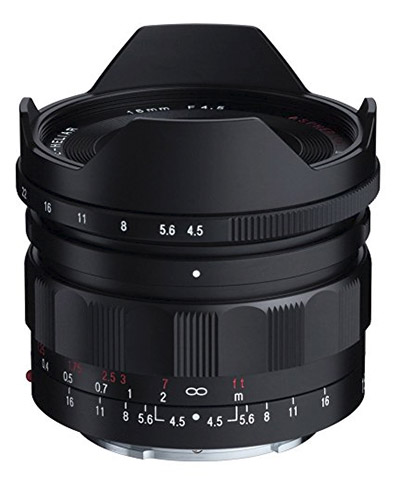
Voigtlander Super Wide-Heliar 15mm f/4.5 Aspherical III Lens
4. Zeiss Loxia 21mm f/2.8 Lens
Now we’re taking another step up in terms of price. Zeiss lenses have an excellent reputation, but they’re not cheap. This one is a 21mm prime lens. It’s not the widest of wide angles, but if it suits your needs it is an excellent choice. This lens is made for cameras with full frame sensors, but can also be used with APS-C sensors (31.5mm equivalent focal length).
This is another manual focus lens. If you’re comfortable with manual focus you can get excellent image quality and corner-to-corner sharpness with this lens. The max aperture of f/2.8 is great as well.
- For full frame or APS-C sensors
- focal length: 21mm (31.5mm equivalent)
- aperture range: f/2.8 – f/22
- 52mm front filter diameter
- auto focus: no
- weight: 14 ounces
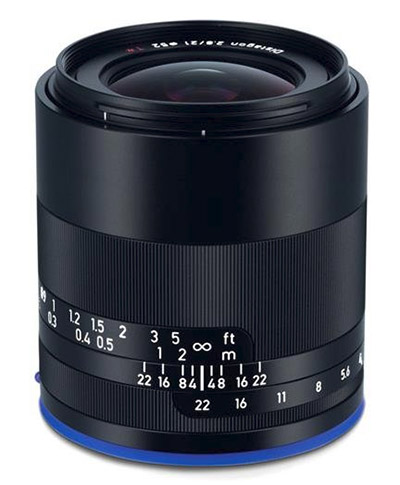
Zeiss Loxia 21mm f/2.8 Lens
3. Zeiss Batis 18mm f/2.8 Lens
Another excellent prime lens from Zeiss, this one provides a bit of a wider angle at 18mm. Like most of the other lenses here, it is intended for full frame cameras but can also be used with an APS-C sensor (27mm equivalent). This lens does have auto focus. It also has an OLED display that will highlight the focus distance and depth of field range.
The lens is also dust and weather sealed, which is useful since you won’t always be shooting in ideal weather conditions. Overall, this is an excellent quality lens that will produce very good images. The the focal length meets your needs and it is within your budget, it will be an excellent choice.
- For full frame or APS-C sensors
- focal length: 18mm (27mm equivalent)
- aperture range: f/2.8 – f/22
- 77mm front filter diameter
- auto focus: yes
- weight: 12 ounces
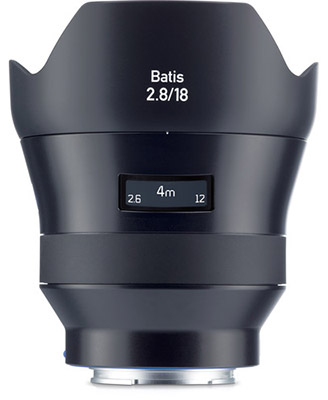
Zeiss Batis 18mm f/2.8 Lens
2. Sony FE 16-35mm f/2.8 GM Lens
The 16-35mm focal range is a popular choice for a wide angle lens. 16mm is quite wide an a full frame camera (this lens can be used with a full frame or APS-C sensor), so this gives you a great range. All of the lenses we’ve covered so far have been prime lenses, but our top two choices are zoom lenses. You’ll pay more for a zoom lens, but it gives you much more versatility, which is why we like them. One downside of the zoom lens is the added weight, as compared to a prime lens.
This lens has a constant max aperture of f/2.8, which is a slight advantage over our top-rated lens. It is also dust and moisture sealed. Like other lenses in Sony’s G Master line, this one is of excellent quality and is capable of very sharp photos. If you’re in the market for a wide angle zoom for a full frame mirrorless camera, this is an excellent choice.
- For full frame or APS-C sensors
- focal length: 16-35mm (24-52.5mm equivalent)
- aperture range: f/2.8 – f/22
- 82mm front filter diameter
- auto focus: yes
- weight: 1.5 pounds
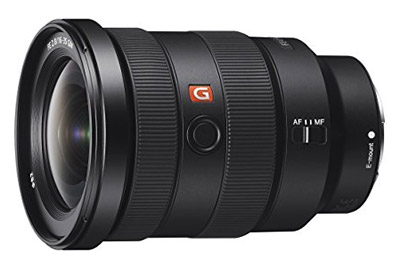
Sony FE 16-35mm f/2.8 GM Lens
1. Sony FE 12-24mm f/4 G Lens
Our top rated wide angle lens for the Sony E mount is the Sony FE 12-24mm f/4 G lens. The reason we have this one rated higher than the 16-35 f/2.8 is because the wide focal length that can come in very handy for landscapes. The different between 16mm and 12mm may not sound like a lot, but as you get that wide each mm makes a noticeable difference.
On the downside, this lens has a max aperture of f/4 as compared to the f/2.8 of the 16-35mm lens. However, f/4 will meet your needs for landscape photography 99% of the time, and the f/4 will save you some money as compared to the f/2.8.
This lens is also dust and moisture sealed, and capable of capturing beautiful and sharp photos.
- For full frame or APS-C sensors
- focal length: 12-24mm (18-36mm equivalent)
- aperture range: f/4 – f/22
- no front filter thread
- auto focus: yes
- weight: 1.25 pounds

Sony FE 12-24mm f/4 G Lens
How to Choose the Right Wide Angle Lens
We’ve covered 8 excellent options on this page, but there are some significant differences between these lenses. The Rokinon 12mm lens is made only for APS-C sensors, while all of the others can be used with an APS-C or full frame sensor. However, those lenses are intended for full frame lenses and you can find cheaper, lighter options for an APS-C sensor.
Another major difference is that our two top-rated lenses are zoom lenses, and all of the others are prime. We recommend a zoom lens for its flexibility, but prime lenses do offer some benefits. They are generally lighter, and more significantly, they’re less expensive. So we recommend that you decide if you want a prime or a zoom lens and that will narrow down the choices for you.
Four of the lenses covered here have auto focus, while the other 4 are manual focus only. If you need to have auto focus, that will also narrow down the choices for you.
Although all of these lenses are wide angle, some are wider others. Just how wide do you need? If your primarily shooting landscapes it is good to have an ultra wide angle lens in your bag. It’s likely that you will use it a lot.
Use all of these factors, and of course budget, to help you determine which one is right for you.